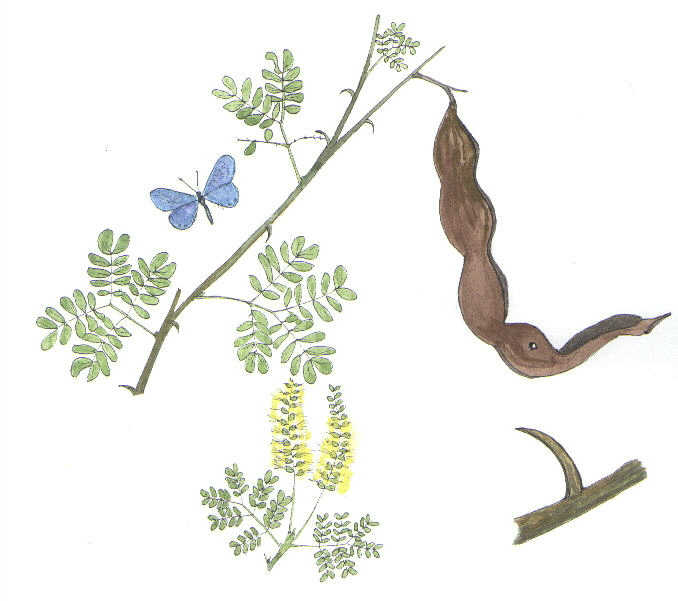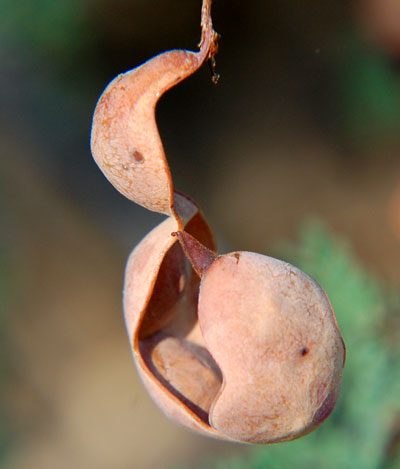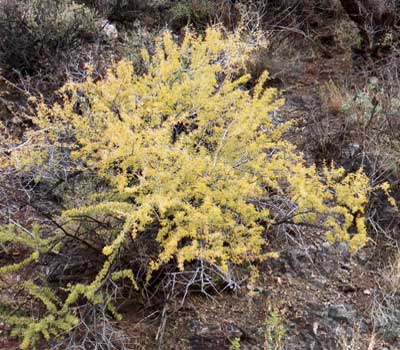Catclaw Acacia
Acacia greggii
Senegalia greggii

Watercolor from live specimen found at Organ Pipe Cactus National Monument, Arizona, April 27, 1992. The blue lycaenid butterfly is the Marine Blue, Leptotes marina. The butterflies often take nectar at acacia flowers and the larvae eat the leaves.
Sponsored Links:

Mature Acacia greggii pod observed along Mesquite Wash, Maricopa Co., Arizona, August 2009.
ARMED : During your first encounter with the flora of Arizona, this
ubiquitous shrub will likely find you first! The impossibly sharp, hooked
spines will tug at your clothing, and surely scratch and tear any exposed skin.
Later you will cuss a bit as you work to extract the broken off spine-tips from
your flesh and clothing. The scars of your desert trek will be a sign to
friends and co-workers of your outdoorsy nature.
SHRUB: 2 to 4 m tall, but with a good water supply Catclaw Acacia can
grow to small tree size - and a very attractive one at that!
LEAVES: Twice compound leaves typically have four sets of 10 leaflets.
Leaves remain on the plant well into drought periods, but are frost sensitive;
the leaves turn yellow by late fall.
FLOWERS: Dense spikes of cream colored flowers emit powerfully sweet
fragrance. Blooming mostly April and May. Like the other members of this tribe,
the "flowers" are really dense clusters of flowers with minute petals and long
conspicuous stamens.
FRUIT: Curled or twisted shiny brown pods are 7+ cm long, 1 cm wide, a
bit woody and with five or so hard brown seeds.
RANGE: A common component of the vegetation throughout the Sonoran
Desert, especially along washes.
 After you're through cussing this shrub, stop to
observe its beauty and the diverse fauna that thrives on it. Even along the
driest washes this shrub often presents a lush appearance with stems densely
clothed in feathery leaves. The highly fragrant flowers are visited by hoards
of beetles, bees, flies, wasps, and butterflies. A very small butterfly is
nearly always to be encountered at the flowers, the Marine Blue, Leptotes marina.
After you're through cussing this shrub, stop to
observe its beauty and the diverse fauna that thrives on it. Even along the
driest washes this shrub often presents a lush appearance with stems densely
clothed in feathery leaves. The highly fragrant flowers are visited by hoards
of beetles, bees, flies, wasps, and butterflies. A very small butterfly is
nearly always to be encountered at the flowers, the Marine Blue, Leptotes marina.
Fabaceae - Bean Family
Mimosoideae - Mimosa Subfamily
More Information:
- Jepson Manual Treatment
- Firefly Forest - Tucson
- USDA Plant Profile
- ITIS Taxonomic Report
- Google Images
- Google Scholar Literature Search
